Installing a washing machine in a kitchen unit
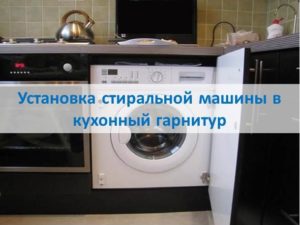 The most popular place to install a washing machine is the bathroom. But not every bathroom is able to accommodate a rather large unit, and high humidity is harmful to electrical appliances. It is safer, more functional and more convenient to integrate a washing machine into the kitchen unit, so as not to disrupt the uniform style and not attract unnecessary attention. We’ll tell you in this article how to organize “relocation” competently and beautifully.
The most popular place to install a washing machine is the bathroom. But not every bathroom is able to accommodate a rather large unit, and high humidity is harmful to electrical appliances. It is safer, more functional and more convenient to integrate a washing machine into the kitchen unit, so as not to disrupt the uniform style and not attract unnecessary attention. We’ll tell you in this article how to organize “relocation” competently and beautifully.
Advantages and disadvantages of this option
Before planning drastic changes in the interior, let's consider all the pros and cons of embedding a machine under the countertop. Let's start with the positives.
- Functionality. The top cover does not stand idle, but is hidden under the tabletop, which is actively used.
- Safety. In a kitchen with humidity and air conditioning, things are better, which directly affects the quality and durability of the unit.
- Aesthetics. In the bathroom, the washing machine looks “alien” and stands out from the interior, and in the kitchen, due to a single countertop, similar stove and refrigerator, it looks harmonious and appropriate. There are also no strict restrictions on the location of the machine.
- Silence. It is not guaranteed to be completely noise-free, but a wood frame will significantly reduce the decibels coming out.
- Saving. The set allows you to hide the unit from prying eyes behind a cabinet door, so there is no need to overpay for a fashionable and stylistically appropriate cabinet design.
As for the disadvantages, they include limited access to the machine, which in case of repair will require additional effort.The list continues with the impossibility of storing dirty things in the machine and the need to constantly take away/bring back the cleaning products placed in the bathroom. Some people find it inconvenient to load and unload laundry because the door gets in the way.
Existing solutions
There are many options for integrating washing machines into a kitchen set - it all depends on the imagination of the residents, room layout, budget, access to communications and available furniture. Moreover, the stage of the rearrangement is important, since when planning a completely new interior, there will be more freedom and possibilities in choosing a suitable place for the machine. But the basic solutions proposed by designers will remain unchanged. Let's look at each one.
Under the work surface of the table top
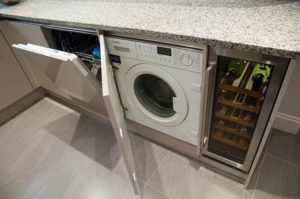 It is popular to install the washing machine deep into the unit: under the worktop and behind the front door. It is best to choose this option if the kitchen interior is thought out to the smallest detail and a “foreign” washing machine will ruin the entire created atmosphere. In addition to aesthetics, complete integration and reduced noise levels are good. This method will also work for machines with vertical loading of laundry, with the only difference being that a folding tabletop is installed.
It is popular to install the washing machine deep into the unit: under the worktop and behind the front door. It is best to choose this option if the kitchen interior is thought out to the smallest detail and a “foreign” washing machine will ruin the entire created atmosphere. In addition to aesthetics, complete integration and reduced noise levels are good. This method will also work for machines with vertical loading of laundry, with the only difference being that a folding tabletop is installed.
The main thing is to correctly approach the arrangement of existing household appliances. It is undesirable for several devices to be located nearby due to the heating of their housings; otherwise, it is necessary to think about thermal insulation. We also take into account the vibration emanating from the unit.
With open front
When the washing machine has a stylish design and matches the color and texture of other furniture, it is not necessary to hide it behind the door.Moreover, a single metallic shade of all household appliances, as well as hoods and countertops, is one of the most popular design solutions. But even a machine gun that stands out from the general interior can be “embellished” in the following ways:
- cover with a special decorative film to match;
- paint the body a certain color;
- order individual decor from specialized companies.
Then it will be easier to use the washing machine, since there will be no need to control another door.
But there is also a pitfall. Appliances that are built-in with an open front must fit perfectly into the planned space without gaps or protrusions.
Unusual embedding
For those who like to surprise, another option is suitable - to mount the machine in the middle of an elongated headset. Niches remain free for use under and above the equipment. By “raising” the equipment 30-40 cm from the floor, safety increases, because the intervention of children or pets is excluded.
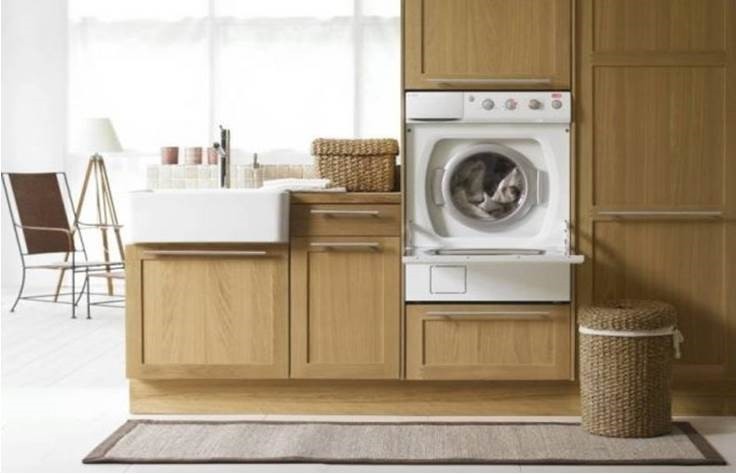
This arrangement is unusual and very organic for minimalist interiors. There is another advantage: loading and unloading laundry from the drum is easier and faster, since there is no need to bend over or squat. There is one “but”: the development and implementation of such an idea into reality will require a lot of money and effort.
Getting ready for installation
You can place the washing machine between two cabinets, in a separate sector with a door, or add an individual door to the machine in the provided furniture hinges on the body. In any case, there is a tabletop on top, and a special panel below. The following conditions must also be met: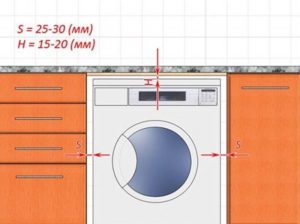
- Free air circulation is ensured, for which the rear wall is not mounted or removed.
- The machine is placed on a stable surface: the floor, a cabinet or a cabinet (in extreme cases, the base of a cabinet with mandatory reinforcement).
- We level the body of the machine by changing its position with a building level and rotating special regulators on the legs.
- We leave free space between the countertop and the top of the unit to ensure easy opening of the detergent tray (if this is not possible, you will have to pour the powder directly into the drum).
Taking into account the above points, you can extend the life of the washing machine and simplify its use. In addition to the prepared space for installing the “home assistant”, we also collect the tools necessary for installation. These include a tape measure, pliers, an indicator screwdriver, a knife, metal clamps, a level, an adjustable wrench, a filter, a hose, a siphon and a cuff.
Let's connect to communications
Now let's start connecting the machine to all the necessary communications. We are talking about sewerage, water supply and electrical networks. If the upcoming work is in doubt, call a repairman from the service center, since the health of users and the durability of the device depend on the correctness of the lines. However, there is no need to worry too much - it’s not difficult to connect the machine yourself.
We start with organizing the drain: take the drain hose and put it on the installed siphon. We securely fix it with a metal clamp.
Important! Organizing the drain can be simpler: lower the free end of the hose into a nearby container or sink.
Next in line is setting the water supply. Find the curved end of the inlet hose and screw it to the washer.We make a branch on the water pipe by screwing in a special tee. We install a filter, especially if the water entering the house is too hard. We attach the hose with wiring and tighten it with a clamp. At the end we connect to the power grid.
- We allocate a separate socket and an individual output to the machine.
- We organize grounding or connect it to an electrical circuit RCD with a cutoff current of at least 30 mA.
- We connect a stabilizer to eliminate the harmful effects of voltage surges.
- We stretch the cord to the outlet so that there is no squeezing or kinks.
Attention! Extension cords are not safe to use.
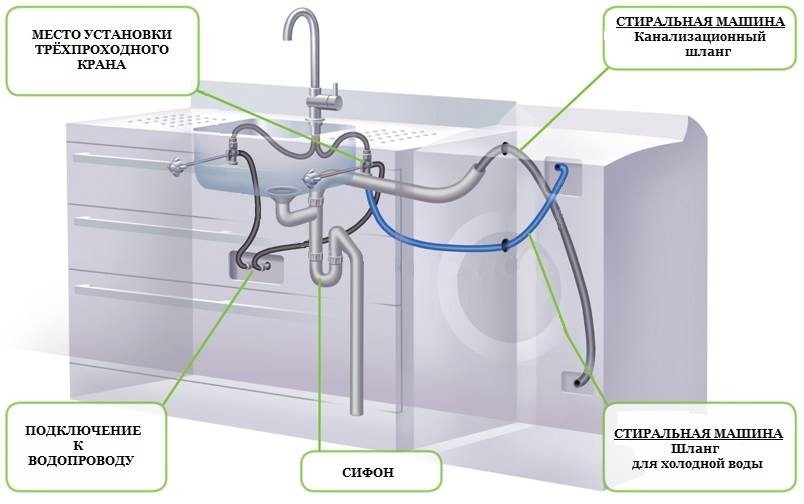
All that remains is to place the connected washing machine in the provided box. This is not as easy as it seems, because the average weight of the machine starts from 55 kg, and the body is smooth without protruding elements. We must not forget about the connected hoses and wires. It is best to ask a friend or neighbor for help to prevent broken cords or other related problems.
Interesting:
Reader comments
- Share your opinion - leave a comment


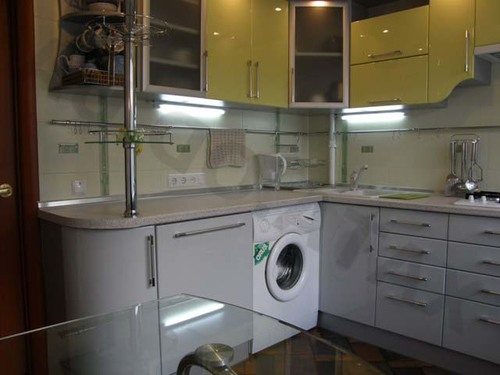

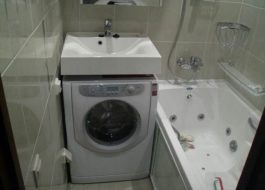

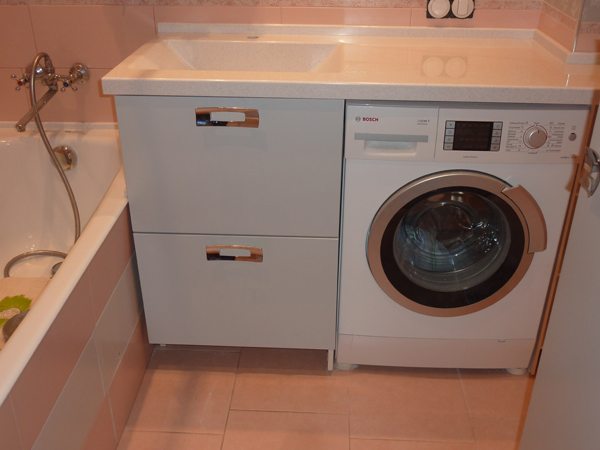














Add a comment